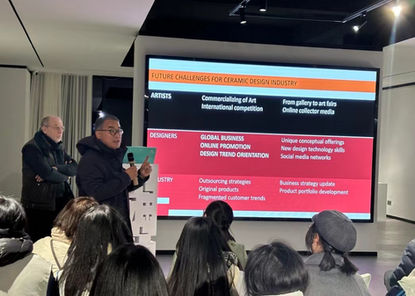
景德镇陶瓷大学龙泉研究院
2023年12月17日
讲座·第一期|身处行业中的艺术家和设计师所面临的挑战——Tapio Yli-Viikari
On December 17, 2023, the renowned Finnish designer Tapio Yli-Viikari delivered a captivating lecture at the Longquan Research Institute of Jingdezhen Ceramic University. The focal point of this engaging session was "Challenges for artists and designers working for industry."
12月17日,景德镇陶瓷大学龙泉研究院邀请了陶瓷设计师Tapio Yli-Viikari,带来题为《身处行业中的艺术家和设计师所面临的挑战》的讲座。龙泉市委常委、副市长孔金峰,景德镇陶瓷大学龙泉研究院执行院长金文伟,丽水职业技术学院龙泉分院及龙泉青瓷宝剑技师学院90余名师生,龙泉青瓷陶艺创作工作者及从业人员参加了此次讲座,讲座现场座无虚席。
Tapio Yli-Viikari shared his artistic experiences and the achievements in the development of the Finnish ceramics industry during the lecture, expressing high expectations for the students present. Yli-Viikari first introduced the history of Arabia Ceramic Factory, explaining the establishment and naming reasons for the ceramics factory. He detailed the contributions of early artist Thure Öberg to the factory and the history of the closure of Arabia Ceramic Factory in 2016. At the same time, he shared the works of his mentor Kaj Franck and other Finnish designers. During the lecture, Tapio Yli-Viikari also reviewed the history of the Finnish design industry, emphasizing the role of design in uplifting the spirits of the Finnish people during World War II and the importance of design in establishing the image of Finnish industry and the nation.
Tapio Yli-Viikari在讲座中介绍了自己的艺术创作经历与芬兰陶艺界发展的成果,并对在场学生们寄予厚望。Yli-Viikari首先介绍了Arabia陶瓷厂的历史,阐述了该陶瓷厂的创立和命名原因。他详细介绍了该厂早期艺术家Thure Öberg的贡献,以及Arabia陶瓷厂于2016年关闭的历史。同时,他分享了自己的恩师Kaj Franck以及其他芬兰设计师的作品。在讲座中,Tapio Yli-Viikari还回顾了芬兰设计界的历史,强调了设计在二战期间对振奋芬兰人民人心的作用以及设计在建立芬兰工业形象和国家形象方面的重要性。
Centered around the theme of "Challenges for artists and designers working for industry," Tapio Yli-Viikari systematically analyzed distinct issues from the perspectives of artists, designers, and the industry.
Concerning artists, he addressed the transformation from traditional gallery exhibitions to art fairs, the emergence of online collector media, the commercialization of art, and the intensifying global competition. Turning to designers, Yli-Viikari emphasized aspects like globalized business practices, the significance of online promotion, the orientation towards design trends, the creation of unique conceptual products, the acquisition of skills relevant to the modern era, and the pivotal role of social media networks. From an industrial standpoint, he delved into outsourcing strategies, the emphasis on original product development, adapting to diverse customer trends, the continual evolution of business strategies, and the exploration of diversified product portfolios.
围绕着主题:艺术家和设计师在行业中所面临的挑战,Tapio Yli-Viikari分析了来自艺术家、设计师和产业三个角度的不同问题。艺术家方面,他提到了从画廊到艺术博览会的变革、网络媒体的收藏家、艺术商业化和国际竞争。设计师方面,他关注了全球化业务、在线推广、设计趋势导向、独特概念性产品、新时代技艺与技能和社交媒体网络。产业方面,他谈到了外包策略、原创产品、客户需求趋势、商业策略更新和产品组合开发。
Tapio Yli-Viikari also shed light on the role played by the Arabia Art Department and the Art Department Association in Finland, emphasizing their contributions to perpetuating the design philosophy of the Arabia Ceramic Factory. As a graduate of Finland's Aalto University, Yli-Viikari highlighted the university's endeavors to explore creative design using diverse materials and integrating advanced technological tools in the design process. He underscored the important role of incorporating new technologies in the future development of the ceramic industry, drawing insights from his own experiences.
In conclusion, Tapio Yli-Viikari encouraged students to uphold the heritage of Longquan Celadon culture, acquire new skills, and seamlessly integrate artistic and design philosophies. He emphasized the importance of students contributing to the continuity and innovation of Longquan Celadon culture. Following the lecture, students engaged in discussions and exchanges with the artist, sparking new reflections on the future of ceramics.
Tapio Yli-Viikari还介绍了位于芬兰的Arabia艺术部和艺术部门协会在延续Arabia陶瓷厂设计理念方面的作用。他毕业于芬兰阿尔托大学,指出学校正在尝试运用不同材料进行创意设计,并引入了先进的科技技术辅助设计。他通过自己的设计经历强调了新技术的应用对陶艺业未来发展的重要性。最后,Tapio Yli-Viikari鼓励学生传承龙泉青瓷文化,掌握新技能,将艺术与设计理念相融合,为龙泉青瓷文化的传承和创新贡献力量。讲座后,学生与驻场艺术家展开了交流讨论,对陶艺未来提出了新的思考。





